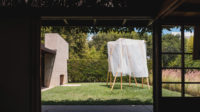Designers strive to provide super-low-cost dwellings worthy of being called homes.
When Román Viñoly, a director at his father's firm Rafael Viñoly Architects, visited Chile in 2010, he toured an affordable-housing project on the outskirts of Santiago that by all measures should have been a success. It provided clean, structurally sound houses for Chileans who had previously lived in self-constructed slums. The problem? The rows of identical, cookie-cutter units felt more like cellblocks than homes, and their one-size-fits-all approach alienated residents who were used to arranging their dwellings to suit their family structures and living habits. “You saw people vandalizing their own homes, writing graffiti on their own houses,” says Viñoly, who this spring is building a prototype for a low-cost modular house that residents will be able to configure themselves.
Viñoly's project is part of the latest wave in an effort to design extremely low-cost permanent shelters for people around the globe who lack adequate housing. Inspired by ambitious goals, such as the $100 house proposed by author and social entrepreneur Paul Polak in his 2008 book Out of Poverty, these new designs use different degrees of standardization to push down costs, but they also give homeowners a lead role in determining how their houses will look and function.
Residents of Trapyan Anchang, a village in Cambodia, will get a menu. Commissioned by the country's Habitat for Humanity chapter, the Phnom Penh firm Collective Studio designed a series of six house types for the village. Their plans vary to fit different ways of living, but each model provides waste- and water-management systems, passive cooling, and other improvements over existing housing. Last fall a team that included the residents built prototypes of the first three designs, and three more will be completed this year. The firm kept the average construction cost near $2,500 by relying on simple building methods and specifying plywood, concrete block, and other locally available materials. Residents will eventually be able to select which of the six designs best suits their households.
But most impoverished communities lack the luxury of a construction project backed by a major nonprofit. To bring them better, inexpensive homes, many designers see potential in do-it-yourself modular systems. While pursuing her M.Arch. at MIT, designer Ying Chee Chui responded to a challenge to propose a $1,000 dwelling with the Pinwheel House, a variation on a traditional Chinese courtyard structure. Based on L-shaped modules of hollow bricks threaded onto steel bars, the house can be expanded with new components around the perimeter. “If you can build one-quarter of the house, you can build the rest,” says Chui. A 970-square-foot prototype completed in 2010 for a farming family in Sichuan, China, cost $5,900 to build, but Chui says it demonstrated the design's capacity to keep expenses down while still allowing for customization by putting construction in the community's hands.
The designers of WikiHouse, an open-source modular building system, share Chui's enthusiasm for employing local manpower, but they combine it with a high-tech delivery method. On the WikiHouse website, users can download SketchUp files for a series of components. Then, using what the designers envision as a donated or collectively owned CNC milling device, they can “print” the component pieces of a wood structure to be assembled on-site. “Most cities are made by the users, not by real-estate developers,” says Alastair Parvin of 00:/, the London design firm behind the project. “Putting tools and knowledge into the hands of everybody is really important.” The firm estimates the construction cost for the structural components at about $14 per square foot, depending on location. “Our ambition is that it should be at least as easy as an IKEA kit to put together,” says Parvin. “It's like building by numbers.”
IKEA's flat-pack approach also informs the design for Tecnocasa, a venture-capital-backed project for Guerrero, Mexico, that begins prototyping this spring. The Mexico City—based engineering firm ETXE and industrial-design firm AGENT devised a Lego-like system of large but lightweight bricks. Six different shapes made from two molds will enable residents to assemble rooms of a size and layout of their choosing. “It actually looks a bit like Tetris,” says AGENT's Tom Pelzer. The designers expect it will take two people four to seven days to thread the bricks onto a steel structure (a similar process to that of the Pinwheel House) and build a basic $6,700, 385-square-foot dwelling.
Viñoly's concept, called Casapanal, is also highly configurable, but it uses a different set of materials for speedy construction: a metal skeleton fitted with structural insulated panels (SIPs). “They can be handled without heavy machinery, like an erector set,” says the architect. The project would allow families to build a 370-square-foot house with a kitchen, bath, and dual living room/bedroom. “This is a system that you could buy, lay out on your property, sit down with your husband and your kids, and say, 'Well, how do we want it to look?' ” Viñoly says.
That's the promise common to each of these ideas: they will empower residents to take control of the design process. “One of the features of this system is to do away with the need for an architect,” says Viñoly, “and to make it possible for people to build a house that responds to their needs.” How these projects will perform is still largely untested, but providing houses that are not only inexpensive but that residents are proud to call their own will be the greatest measure of their success.
RECORD.











Post a comment to this article
Report Abusive Comment